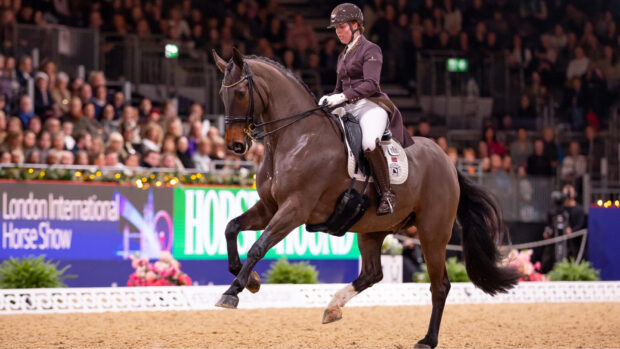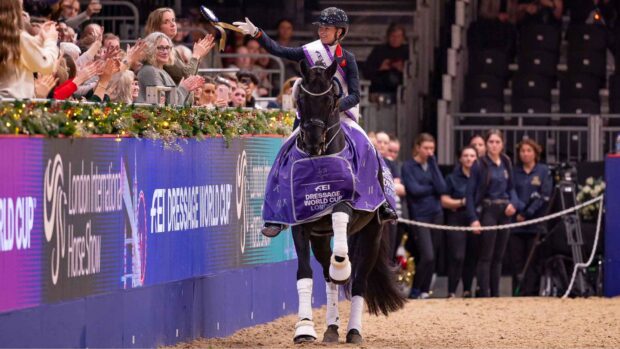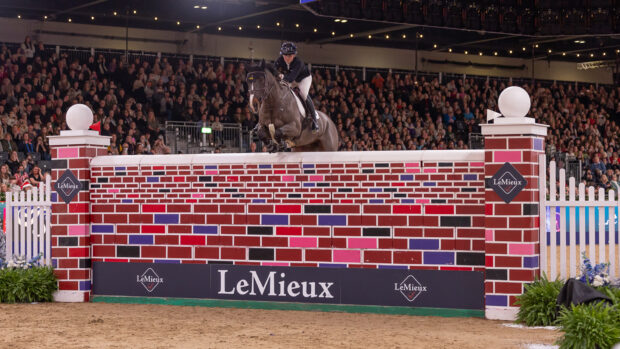The FEI is looking to tighten its noseband rules by moving away from fingers to a standardised way of measuring.
The move would also include elimination and a yellow card for those found to be using over-tightened nosebands in competition.
The suggestions are made in the first draft of 2024 FEI rules, released on 28 June, and would bring all disciplines into line. The FEI’s rules revision process means national federations and stakeholders have until 16 August to give feedback.
The proposed change came from a recommendation by the FEI equine ethics and wellbeing commission. This was for a “general provision harmonising the approach measuring the tightness of nosebands” across disciplines, using an “FEI objective measuring tool”.
Questions remain, such as how and where tightness will be measured, but the intention is to have answers in coming weeks in order for this to be a full proposal by the autumn.
“‘Fingers’ are a subjective measuring unit, as they differ in size and as such do not provide consistency in measurements of noseband tightness at FEI events,” states the FEI explanation.
“The FEI proposes to introduce an FEI objective measuring tool, which will provide the repeatability and consistency in measuring the tightness of nosebands. This will ensure that the same horse welfare standards are applied globally across all FEI events while providing clarity for all FEI stakeholders.”
It is also notable that the FEI intends to outline protocols for measuring nosebands in a “flexible document, not regulated in the rules, and amended if needed”. This means that it could, theoretically, be changed and added to without having to go through the FEI’s lengthy rules revision process.
The proposed rule states that nosebands – upper and lower – “must be adjusted with sufficient laxity”. The consequences of an “excessively tightened” noseband would be that pre-competition, the horse and rider would not be allowed to start unless the noseband is loosened; during combination, they would be eliminated and the rider given a yellow warning card.
New equestrian charter
The FEI is also seeking to add an “equestrian charter” to its rules for 2024, which acknowledges horses’ wellbeing, sentience and that welfare is a priority (news, 4 May).
“Equine welfare involves the physical, psychological, social and environmental wellbeing of the horse, and all horses involved in sport and leisure activities should be able to live a good life,” it states.
It would require all those involved in horse sport to uphold three pledges. These are to “understand it is a privilege to involve horses in sport and this comes with responsibilities to the horse”, to commit to respecting the horse “as a sentient creature capable of feeling both positive and negative emotions, and to ensure its welfare is always my priority”. And to “continually develop” understanding of equine behaviour and welfare needs, and to proactively use this knowledge to provide a “good life for horses with which I am involved”.
Other proposed rule changes
An increase in the minimum age of event horses at the top level, a suggestion of an under-25 Europeans, plus a rejig of minimum eligibility requirements for horses returning to competition are all also being considered.
The French federation has put forward the idea of upping the minimum age of event horses eligible to compete at senior Europeans, and at five-star, from eight to nine years old.
“We propose to increase by one year the minimum age of horses in order to emphasise on the progressive pathway needed to access to that level. It contributes to horse welfare measures,” states the French submission.
The FEI agreed, adding that this “would be beneficial from a horse welfare point of view”.
The German and Irish federations both “strongly” recommended the introduction of an under-25 European Eventing Championships “most preferably at CCI4*-L”. Although the sport is unlikely to see this in 2024, it is on the table for the future.
The FEI’s eventing committee said it is a “good proposal to bridge the age gap”, suggesting it be included in the next revision of the eventing rules.
“For risk management reasons this addition could provide an intermediate level between young riders and seniors competitions,” said the FEI eventing committee.
Teething problems with the “problematic” 2023 rule on event horses returning to competition following a break will also be attempted to be ironed out for next year.
The current rule requires four- and five-star horses who have been away from FEI competition for 13 months or more to achieve a qualifying run at the level below, before stepping back up. But the way the current rule is implemented has caused a “cascading effect”, meaning certain horses are dropping down more than one level. The FEI has tweaked the wording to fix this.
The final draft of 2024 rules will be released in October, ready to be voted on at the FEI general assembly in November and come into force next year.
You might also be interested in:

Subscribe to Horse & Hound magazine today – and enjoy unlimited website access all year round

Plan to allow dressage riders to ditch their spurs completely at top level

Calls for changes to elimination rule over ‘serious concerns’
Horse & Hound magazine, out every Thursday, is packed with all the latest news and reports, as well as interviews, specials, nostalgia, vet and training advice. Find how you can enjoy the magazine delivered to your door every week, plus options to upgrade your subscription to access our online service that brings you breaking news and reports as well as other benefits.




